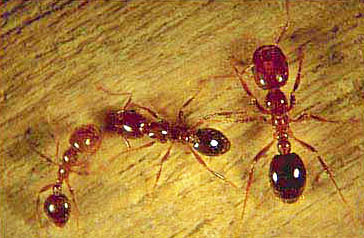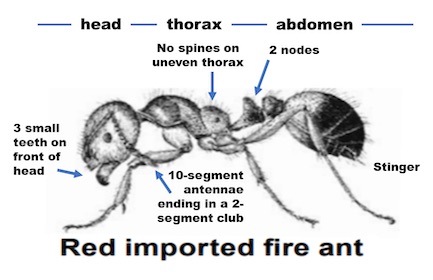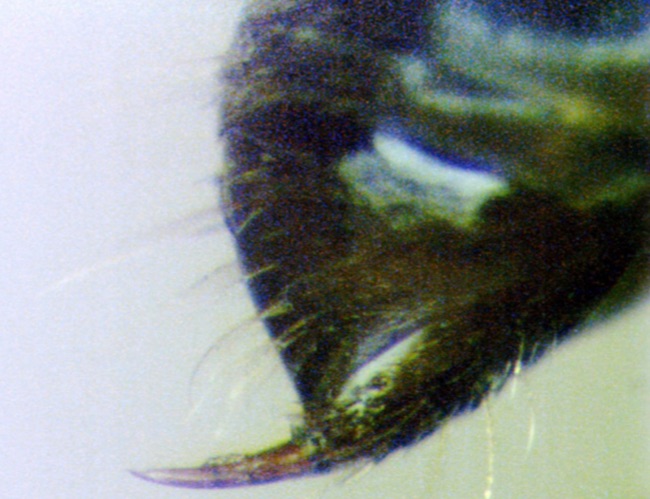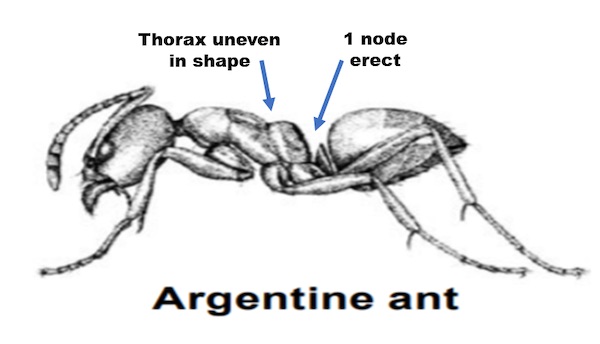Invasive Ants in Virginia: Unwelcome and Painful Pests
By Ann M Mason, Fairfax Master Gardener Intern

Red Imported Fire Ants
In 1989, the red imported fire ant (RIFA) (Solenopsis invicta) was collected initially in Hampton Roads. While there are four species of fire ants in the U.S., S. invicta is the most problematic. The RIFA is a two-node ant with an uneven thorax without spines. It has multiple teeth on the front of the head, large eyes, a sharp stinger at the end of the abdomen (gaster) and a 10-segmented antennae ending in a two-segmented club. RIFA usually has a shiny reddish-brown head and thorax, but male ants that are reproductively active (swarmers) are completely black. In some areas, RIFA has interbred with and completely displaced the black invasive fire ant (S. richteri).

Red Imported Fire Ant
Generally, we first notice a fire ant colony from mounded nests of disturbed soil. Fire ants prefer to build their mounding nests in open sunny areas, like pastures, parks, cemeteries and around food sources (garbage, gardens and walkways). In sandy soils, these mounds can extend 10 to 24 inches in diameter and 6 to 8 inches tall. In heavy clay, the mounds can be larger, reaching 24 to 36 inches in height and stretching to about 4 to 6 feet underground. However, in some areas the nest might appear flat, not mounded.
I experienced fire ants first-hand when I lived in Texas. Swarms of stinging ants can result in serious life-threatening danger. And these ants are not easily brushed off! They hang on by grasping their victims with their mandibles (jaws) while continuing to jab multiple times with their stingers. This results in a circular sting pattern that can result in a blister-like sore (pustule), which can become infected.
In the southern VA counties of York, James City, Brunswick, Greensville, Isle of Wight, Mecklenburg and Southampton, the Red Imported Fire Ant is so prevalent that the VA Dept of Agriculture and Consumer Services is implementing the Federal Fire Ant Quarantine. Consumers in those counties will need to call commercial pest control services who have specialized treatments to control these invasive, swarming pests.
Consumers in our Northern VA area should report immediately any sighting of RIFA to the VA Dept of Agriculture and Consumer Services (DACS), Office of Plant & Pest Services at 804-786-3515. Because improper and incomplete control measures allow the RIFA to spread quickly, the Department asks consumers and pest applicators in our and other non-quarantine areas to allow the DACS Office of Plant & Pest Services to treat these mounded nests.
What we can do? Heed the quarantine. Do not ship or introduce plant materials, sod or mulch from infected areas in VA or other states into our gardens. Be aware and attentive and immediately report any observation of RIFA to the VA Department of Agriculture and Consumer Services, Office of Plant & Pest Services, at 804-786-3515.

Asian Needle Ant Stinger
Asian needle ants inhabit both natural, undisturbed areas (forests) as well as areas disturbed by human activity. These ants favor damp areas below stones, rotting logs or in mulch. The Asian needle ant has been reported to forage inside home kitchens, school cafeterias and garbage cans, which can lead to an infestation. One unique characteristic of the Asian needle ant is the ability to cling and climb smooth surfaces like glass. Experts report this ant can supplant our native ant species to upset and devastate the balance of nature by eliminating seed dispersal and the predation of forest pests performed by our native ants. Sadly, VA Tech experts report that the efficacy of ant baits is unclear and being researched.
 The Argentine ant (Linepithema humile) has one erect node, an uneven shaped thorax and 12-segmented antennae without a club at the ends. This ant can establish large colonies and favors potted plants and soil under walkway bricks or stones. It can enter homes looking for water and food. It emits a musty odor when crushed. In contrast to the red invasive fire ant and the Asian needle ant, the Argentine ant does not sting or bite humans. Still, this ant is a nuisance pest with the tendency to form large colonies, often by working cooperatively with other nearby colonies.
The Argentine ant (Linepithema humile) has one erect node, an uneven shaped thorax and 12-segmented antennae without a club at the ends. This ant can establish large colonies and favors potted plants and soil under walkway bricks or stones. It can enter homes looking for water and food. It emits a musty odor when crushed. In contrast to the red invasive fire ant and the Asian needle ant, the Argentine ant does not sting or bite humans. Still, this ant is a nuisance pest with the tendency to form large colonies, often by working cooperatively with other nearby colonies.
The Argentine ant cultivates and tends plant pests by offering its protection in exchange for the pests’ honeydew. This mutualistic behavior imposes an economic threat because these ants can move their pest communities to better food source locations to increase honeydew production. This leads to plant destruction. Scientists have not identified a natural enemy of the Argentine ant and report that broadcast spraying is ineffective because of its deep nests. Ant baits appear to control these ants.
Sanitation in food areas in homes and yards, and closing points of entry into homes, schools and other buildings, are the first lines of action. Careful monitoring of landscape areas allows pre-emptive action before a large colony of these invading ants are established.
Identification of ant species is essential before selecting a bait because ants are finicky eaters that vary in their preference for sweet- or protein-based bait. For areas in the landscape, experts suggest appropriate ant bait be placed around, but not in, the nest. Placing the bait too close to the nest could motivate the ants to move. Indoors, experts recommend ant baits be placed in the ‘track’ of the ants so they can forage the bait and return to deliver the deadly food to the nest. Randomly placed ant bait in the kitchen could encourage new visitors rather than eliminate them.
Resources
• Argentine Ant, Matt Daugherty, Center for Invasive Species Research, University of California,
Riverside
• Asian Needle Ant, T. Michael Likins and Eric Day, Virginia Cooperative Extension, Publication ENTO
29-NP (ENTO-280NP) (2018)
• Asian Needle Ant, Eleanor Spicer Rice and Michael Waldvogel, North Carolina State University
Extension
• Red Imported Fire Ant (RIFA), Dini Miller and Hamilton Allen, Virginia Cooperative Extension,
Publication 444-284
• Nuisance Insects of the House and Yard: Insects in Recreation Areas, Chapter 6, 2019 Pest
Management Guide, Virginia Tech Publication 456-018
• Imported Fire Ant Quarantine Expands, Virginia Department of Agriculture and Consumer Services,
Office of Plant & Pest Services